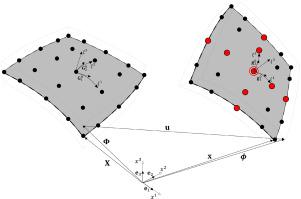基于旋转的几何非线性谱Reissner-Mindlin壳单元
IF 3.5
3区 工程技术
Q1 MATHEMATICS, APPLIED
引用次数: 0
摘要
本文提出了一种基于Reissner-Mindlin运动学的几何非线性谱壳单元,使用基于旋转的公式,并对离散节点旋转向量进行加性更新。以矩阵的形式给出了详细的公式。此外,我们强调了谱元法(SEM)与Gauss-Lobatto-Legendre正交相结合在生成单元刚度矩阵的计算成本方面的优势。为了评估新公式在大变形分析中的性能,我们将其与其他三种数值方法进行了比较。其中一种方法是采用等几何分析(IGA)的几何定义的非等参数SEM壳,另两种方法是不同旋转插值的IGA壳公式。所有的公式都基于Rodrigues旋转张量。通过各种具有挑战性的数值算例的求解,证明了IGA虽然受益于精确的几何表示,但其对求解精度的影响不如形状函数特征和旋转公式的影响显著。此外,我们表明,尽管所提出的SEM外壳的旋转配方更简单,但可以产生与最精确和最复杂版本的IGA相当的结果。最后,我们讨论了最优的扫描电镜策略,强调了采用高阶元素的粗网格的有效性。本文章由计算机程序翻译,如有差异,请以英文原文为准。

A rotation-based geometrically nonlinear spectral Reissner–Mindlin shell element
In this paper, we propose a geometrically nonlinear spectral shell element based on Reissner–Mindlin kinematics using a rotation-based formulation with additive update of the discrete nodal rotation vector. The formulation is provided in matrix notation in detail. Additionally, we highlight the advantages of the spectral element method (SEM) in combination with Gauss–Lobatto–Legendre quadrature regarding the computational costs to generate the element stiffness matrix. To assess the performance of the new formulation for large deformation analysis, we compare it to three other numerical methods. One of these methods is a non-isoparametric SEM shell using the geometry definition of isogeometric analysis (IGA), while the other two are IGA shell formulations which differ in the rotation interpolation. All formulations base on Rodrigues’ rotation tensor. Through the solution of various challenging numerical examples, it is demonstrated that although IGA benefits from an exact geometric representation, its influence on solution accuracy is less significant than that of shape function characteristics and rotational formulations. Furthermore, we show that the proposed SEM shell, despite its simpler rotational formulation, can produce results comparable to the most accurate and complex version of IGA. Finally, we discuss the optimal SEM strategy, emphasizing the effectiveness of employing coarser meshes with higher-order elements.
求助全文
通过发布文献求助,成功后即可免费获取论文全文。
去求助
来源期刊
CiteScore
4.80
自引率
3.20%
发文量
92
审稿时长
27 days
期刊介绍:
The aim of this journal is to provide ideas and information involving the use of the finite element method and its variants, both in scientific inquiry and in professional practice. The scope is intentionally broad, encompassing use of the finite element method in engineering as well as the pure and applied sciences. The emphasis of the journal will be the development and use of numerical procedures to solve practical problems, although contributions relating to the mathematical and theoretical foundations and computer implementation of numerical methods are likewise welcomed. Review articles presenting unbiased and comprehensive reviews of state-of-the-art topics will also be accommodated.

 求助内容:
求助内容: 应助结果提醒方式:
应助结果提醒方式:


